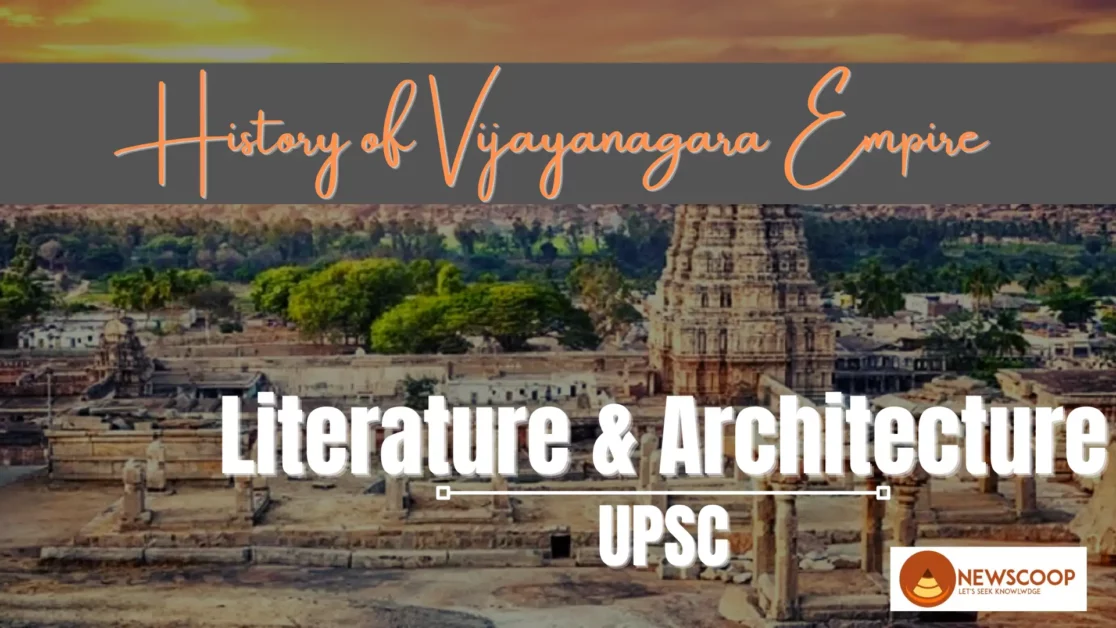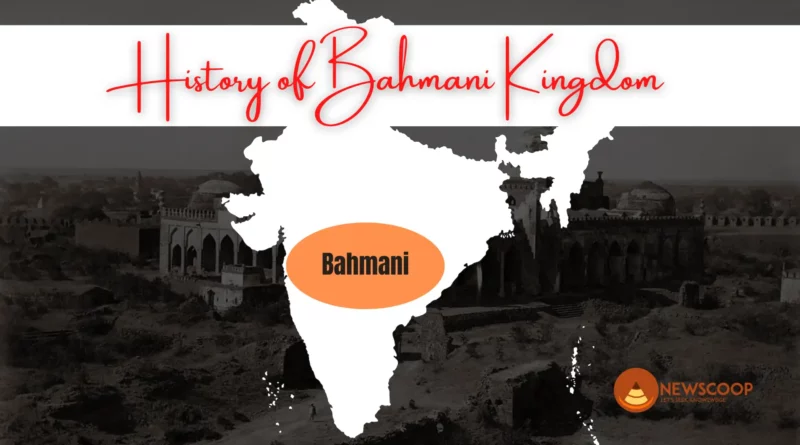Bahmani Kingdom: Rulers, Administration & Decline
If you are searching for the topic “Bahmani Kingdom for UPSC” then you are at the right place. In this article, we mainly focus on the Bahmani Empire. In this, we will discuss the complete history and administration of Bahmani Kingdom for UPSC.
Bahmani Kingdom [1347-1527 AD]
As we all know that from 1350-1565 AD, two important kingdoms rose in southern India. These were the Vijayanagara and Bahmani Kingdoms. Further, they ruled for almost 200 years in the south of Vindhyachal. Both kingdoms built great capital cities and also patronized literature. Further, they establish law & order and also developed handicrafts.
In the mid-14th century, when the Delhi Sultanate was relatively weak and the disintegration of the Sultanate was taking place, southern India was relatively stable. This stability came to an end in 1565 AD after the Battle of Talikota i.e. the decline of the Bahmani Kingdom & Vijayanagara Empire took place.
| Kingdom | Bahmani Kingdom |
| Time Period | 1347-1527 AD |
| Founder | Alauddin Hasan |
| Capital | Gulbarga |
| Founded on | Tungabhadra River |
| Major Enemy | Vijayanagara Empire |
| Architecture | Indo-Islamic architecture |
| Language | Persian |
| Decline | Internal conflicts and external invasions |
History of Bahmani Kingdom for UPSC
Vijayanagara Empire was set up in 1336 AD at the bank of the Tungabhadra River. As they became stronger, they started fighting with other kings. In the north, Bahamani Dynasty was its enemy. Further, in the south, Madurai Sultanate was its enemy.
Bahmani Kingdom came into existence in 1347 AD and it was founded by “Alauddin Hasan”. Alauddin Hasan was the first sultan of the Bahmani Kingdom who grew under the supervision of a Brahman named “Gangu” that’s why he was also known as “Hasan Gangu“. After his coronation, he adorned himself with the title of “Bahman Shah”.
Most of the Delhi Sultanate rulers were Sunni Muslims. Unlike Delhi Sultanate, the majority of the rulers of the Bahmani Kingdom were Shia Muslims. Further, the ‘Bahman Shah’ title was adopted as a tribute to his Brahman patron. This was the reason that this kingdom is named the Bahmani Kingdom. The conflict between Vijayanagara Empire & Bahmani Kingdom was going on from the beginning, and that’s why the history of both is intertwined.
Vijayanagara Empire VS Bahmani Kingdom
The conflict between Vijayanagar and Bahmani Kingdoms was for three places:
- Tungabhadra Doab
- Krishna-Godavari Delta
- Marathwada Country
Persistent military conflicts between both kingdoms were seen throughout time. Further, widespread devastation, loss of lives, and properties happened because of these clashes. In addition, women and children were sold into slavery. In 1367, Bukka-I, the ruler of the Vijayanagar Empire attacked Mudgal Fort and slaughtered the whole garrison.
Further, Bahmani Sultan avenged this by invading Vijayanagar Empire. Bahmani won because of its superior artillery and efficient cavalry. After this, both sides signed a treaty for sharing Tungabhadra doab. The treaty decided that the common public won’t be killed and cruelty will be avoided, hence, it made the war in the South a bit more humane.

At the end of the 14th Century, many struggles took place to capture the Hindu principalities of the east coast. “Reddies” of the upper delta region and the rulers of “Warangal” were the most notable ones. Further, the struggle among Brahmins, the Vijaynagar Empire, and the rulers of Orissa started for this region.
During the time of Hasan Gangu, the ruler of Warangal helped him against the struggle with Delhi. But his successor invaded the Warangal and captured Kaulas and Golconda. Further, Bahmani Sultan fixed the boundary of his empire at Golconda and promised not to encroach on Warangal further.
Famous Rulers of Bahmani Kingdom
- Hasan Gangu Bahmani (The founder of the Bahmani Kingdom)
- Muhammad Shah I (1358-1377 A.D.)
- Muhammad Shah II (1378-1397 A.D.)
- Feroz Shah Bahmani (1397-1422 A.D.)
- Ahmad Shah I (1422-1435 A.D.)
- Muhammad Shah III (1463-1482 A.D)
The most remarkable Bahmani Kingdom ruler was Firuz Shah Bahmani, who ruled from 1397 to 1422 AD.
Firuz Shah Bahmani (1397-1422 AD)
- Firuz Shah had good knowledge of religious science like commentaries of the Quran, jurisprudence, etc. Moreover, he had an interest in a natural science like botany, geometry, logic, etc.
- According to historian Ferishta, Firuz was well-versed in Persian, Arabic, Turkish, Telugu, Kannada, and Marathi Languages. Further, Firuz Shah Bahmani was determined to make Deccan the ‘Cultural Centre’ of India.
- Firuz invited learned men from Iran and Iraq. In addition, he respected all religions, he also included many Hindus in the administration of the Bahmani Kingdom.
- During his reign, the capital of the Bahmani Kingdom was Gulbarga.
- After his reign, Deccani Brahmans emerged as a dominant group in the administration, particularly in the revenue administration. Further, Deccani Hindus prevented the influx of foreigners called ‘Afaqis‘.
- He encouraged astronomy and made an observatory near Daulatabad.
- Further, he paid special attention to the Ports of Dabhol and Chaul. Trading ships from the Persian Gulf and the Red Sea, Luxury goods from different countries used to arrive at these ports.
Firuz Shah Bahmani started the expansion of their kingdom towards Berar. He defeated the Gond King named Narsing Rai of Kherla and captured Berar. In return Narsing Rai gifted elephants, maunds of gold, and 50 maunds of silver. Further, Firuz married Rai’s daughter, which means Firuz Shah Bahmani’s wife was the daughter of Narsing Rai. After that, Kherla was returned to nursing and he was made Amir of it.
Bahmani Kingdom vs Vijayanagar Empire
The 2nd round of conflict between the Vijayanagar and Bahmani Kingdoms was for Tungabhadra doab. Deva Raya-I, the ruler of Vijayanagar ruled from 1404 to 1422. Firuz Shah defeated Deva Raya-I and married his daughter. But the struggle continues for the Krishna-Godavari basin. In 1419, Deva Raya-I defeated Firuz Shah, which weakened the position of Firuz. In 1422, Feroz Shah left the kingdom and his brother Ahmad Shah-I became the new ruler of the Bahmani Kingdom.
Ahmad Shah-I (1422-1436)
Famous Sufi Saint Gesu Daraz was associated with Ahmad Shah. Gesu Daraz was a saint of the Chisti order and a disciple of Nasiruddin Chiragh Dehlavi. Further, Ahmad Shah continues the struggle of South India. In 1424, he invade Warangal and annexed Warangal. Further, he shifted the capital of the Bahmani Kingdom from Gulbarga to Bidar.
After this, he shifted his attention toward Malwa, Gondwana, and Konkan. After the invasion of Warangal, the balance of power in South India got changed. The Bahmani Kingdom gradually expanded, during the prime ministership of Mahmud Gawan, and it reached its Zenith.
Role of Mahmud Gawan in Bahmani Kingdom
- Initially, he was an Iranian trader and became the ‘Peshwa’ during the reign of Muhammad III (1463-1482 AD).
- He got the title of Malik-ut-Tujjar from the sultan.
- For 20 years, Mahmud dominate state affairs and expanded the Bahmani kingdom toward the east.
- They raided deep into Vijaynagar Empire and invaded territories till Kanchi.
- Mahmud’s major military contribution was in the west, where the western coastal areas were overrun including Goa and Dabhol. The loss of these important ports was a big shock to Vijayanagar Empire.
- In addition to this, the foreign trade and internal manufacturing of the Bahmani kingdom got increased.
Malwa Kingdom vs Bhamani Kingdom for UPSC
Since the time of Ahmad Shah-I, the Malwa Kingdom and the Bahmani Kingdom was fighting with each other for various regions like Gondwana, Berar, and Konkan. Malwa kingdom was under the rule of Khiljis. With the help of the rulers of Gujarat, Bahmani captured Berar, on the other hand, Kherla of Gondwana went to Malwa.
Internal Reforms of Bhamani Kingdom for UPSC
- Mahmud divided the kingdom into 8 provinces i.e Tarafs governed by Tarafdar on a fixed salary.
- For maintaining 500 horses, each noble used to get either salary or land i.e Jagirs and were allowed to collect land revenue.
- In each province, Khalisa’s land was kept separately for the Sultan.
- Mahmud built a madrasa in Bidar with Persian influence, which was a new evolution in Indo-Perisian architecture.
- Strife among the nobles was the biggest problem of the Bahmani Kingdom. There were 2 types of nobles, one was a native Muslim, and the other was a foreigner, especially from Persia called Afaqis or Gharibs. Mahmud tried to conciliate but failed, and the sultan executed Mahmud.
What are Afaqis or Gharibs?
The Decline of the Bahmani Kingdom
The decline of the Bahmani Kingdom took place with the death of Mahmud Gawan. After the death of Mahmud, the kingdom further weakened due to court intrigues between Afaqis and Deccani. Khalimullah was the last prince of Bahmani, he was replaced by his wazir Amil Ali Barid and founded the Barid Shahi Dynasty. Sultan Khalimullah Shah was the last ruler of the Bahmani Kingdom.
Further, the Bahmani Kingdom was divided into 5 Kingdoms:
- Golconda
- Bijapur
- Ahmadnagar
- Berar
- Bidar
Click Here: Indian History for UPSC
Conclusion
The patterns of struggle in South India were based on political and strategic considerations, control of trade and commerce, and not religious. Further, the struggles of North and South India were not in complete isolation. Malwa and Gujarat got involved in the conflicts. Further, Bahmani Kingdom acted as a cultural bridge between north and south India and this developed a unique culture.
The kingdom was notable for its cosmopolitanism, religious tolerance, and patronage of the arts and architecture. Its rulers embraced a pluralistic approach to governance, accommodating a diverse range of religious and linguistic communities, and promoting the spread of Persian, Arabic, and Telugu literature and culture.
Despite its eventual decline and fragmentation, the Bahmani kingdom remains an important reminder of the rich and complex history of the Deccan region, and a testament to the enduring legacy of medieval Indian civilization.
Thank You!

Who was the founder of the Bahmani kingdom?
Alauddin Hasan was the founder of the Bahmani Kingdom. He established the Bahmani empire in 1347 A.D.
Which Bahmani ruler shifted the capital from Gulbarga to Bidar?
Firuz Shah Bahmani shifted the capital from Gulbarga to Bidar. His time period was from 1397 A.D. to 1422 A.D.
The Bahmani empire collapsed in?
The Bahmani empire collapsed in 1518 A.D. Sultan Khalimullah Shah was the last ruler of the Bahmani Kingdom.
What was the significance of the Bahmani Kingdom in Indian history?
The Bahmani Kingdom played an important role in the political and cultural history of South India. It was one of the first Muslim states to be established in the region, and its rulers patronized the arts and architecture, creating a unique blend of Islamic and Indian styles.
How did the Bahmani Kingdom come to an end?
The Bahmani Kingdom was gradually weakened by internal power struggles and external attacks from neighboring states, such as the Vijayanagara Empire. In 1518, the kingdom was split into five smaller states known as the Deccan Sultanates, which were eventually absorbed into the Mughal Empire in the 17th century.
Related Links:

